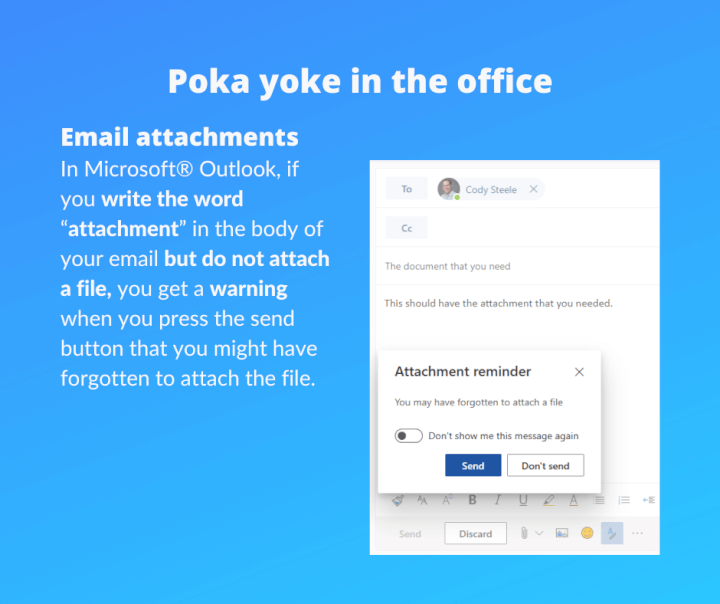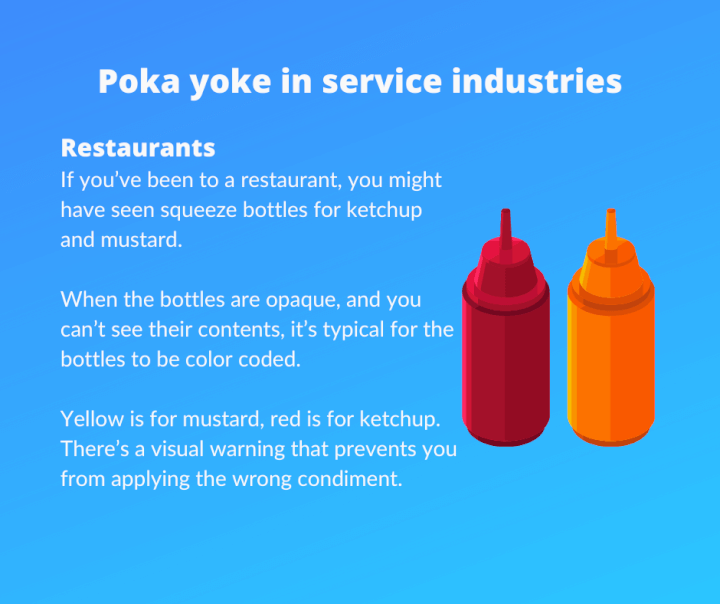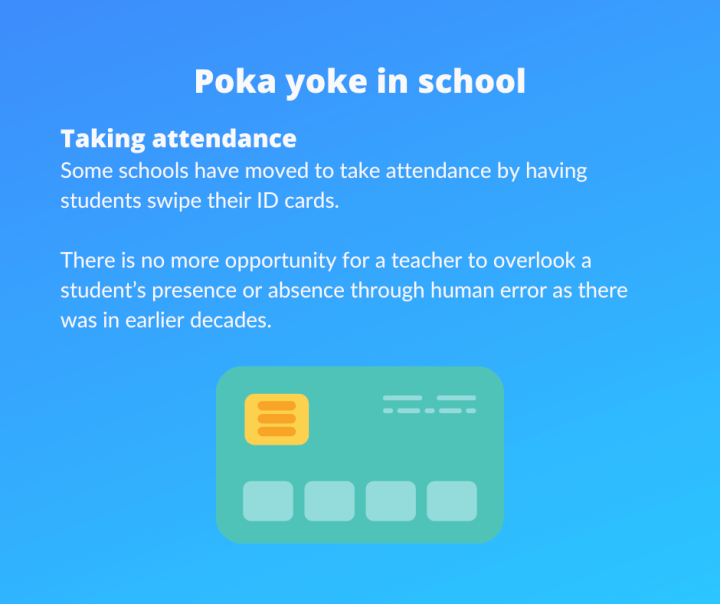What is poka yoke?
In this resource, we’ll discuss some poka yoke examples, but before we dive into that, let’s quickly explore what it actually is.
Poka yoke definition: Poka yoke is a Japanese term that means mistake-proofing (pronounced Poh-kah YOH-kay). It’s a means of thinking about a process so that you can prevent defects from occurring in the first place.
Poka yoke is often divided into two approaches to prevent or detect defects in Lean Six Sigma implementations:
- Control Approach: The poka yoke device controls the process so that when a defect occurs, the process stops until correction takes place. For example, an ATM machine withholds your cash until you have removed your card so that you cannot forget the card.
- Warning Approach: The poka yoke device signals operators when a defect occurs so that operators take corrective action. For example, when word-processing software underlines a misspelled word so that you can go back and fix it.
As you look around your regular life, you can probably identify a number of examples that you see regularly. Let’s take a look at a few mistake-proofing strategies that might be familiar.
Want to learn more about the Lean Six Sigma methodology?
Check out this ebook that will guide you through the key concepts of LSS.
Poka yoke examples in the office
Many modern examples of mistake-proofing in the office appear in computer software.
Email attachments
In Microsoft Outlook, if you write the word “attachment” in the body of your email but do not attach a file, you get a warning when you press the send button that you might have forgotten to attach the file.

This warning gives you the chance to attach a file if you meant to. While this is mistake-proofing, some purists would argue that a poka yoke device should never give a false signal (such as when you write the word “attachment” but do not mean to attach a file).
Data validation
In Microsoft Excel, you can set data validation so that a cell can only contain certain information, like a phone number. Enter a value that doesn’t match the prescribed format and Excel warns you, then forces you to correct the data before you can continue.

In Minitab Statistical Software, a popular software for doing statistical analysis among Six Sigma practitioners, there is a similar poka yoke device.
If you want to do an analysis that works only on a numeric variable, the list of variables that you can select does not contain any column identifiers for text variables. Having only variables that you can use visible to select prevents you from selecting a column that you cannot graph.

More office examples
Anywhere that there is a process that can have human errors, there are opportunities for poka yoke. While the above examples would be easy ones to recognize every day, you can consider these other examples as well:
- Lean Horizons shares their experience applying lean techniques, including poka yoke for data validation, to the Accounts Payable Jake Brake Division of Danaher Corporation.
- Harry Robinson gives an early example of using poka yoke to prevent errors in the localization of software.
Poka yoke examples in service industries
Service industries are a case where we would expect human error to be part of many processes. How many times have you received a product that you didn’t order or had to wait for an error to be fixed before you could get what you want? But mistake-proofing shows up, both in ways that you’d recognize every day and in ways that are less obvious.
Restaurants
If you’ve been to a restaurant, you might have seen squeeze bottles for ketchup and mustard. When the bottles are opaque, and you can’t see their contents, it’s typical for the bottles to be color coded. Yellow is for mustard and red is for ketchup. There’s a visual warning that prevents you from applying the wrong condiment.

Bank cards
Even some common technological advances help eliminate the opportunities for human error. Part of the appeal of using a cash card, debit card, or credit card is that no one has to count back change to you, so there’s no opportunity for error. If a charge is calculated correctly, then the charged price should be correct too.
Amusement parks
In modern amusement park rides, proximity sensors prevent human errors by determining when a roller coaster can start down a track so that two cars are never too close together.
More service industry examples
There’s no shortage of service industry examples as people apply poka yoke to more and more applications. Consider some of the following examples:
- Arash Shahin and Maryam Ghasemaghaei review a variety of poka yoke examples in the service industry. Their work mentions using color bands in hospitals to help people recognize when they are in the correct location.
- Hospitality Technology has a 2012 profile about key card systems that shut off hotel room lights when guests leave their rooms. The system prevents people from leaving the lights on when the room is unoccupied.
- Mark Graban has a short post pointing out that when fast-food restaurants have reusable trays, they can prevent people from throwing the trays away. They can do this by making sure that the holes for their garbage cans are too small to admit the trays.
Poka yoke examples in healthcare
Few industries create as much anxiety in their customers with respect to errors as the healthcare industry. With that in mind, it’s no surprise that the healthcare industry has abundant poka yoke examples.
Healthcare provision is different around the world, so it’s harder to say that these are examples that you would be almost certain to experience, but many of them will at least make intuitive sense.
Dentists
Some dentists provide wristbands when patients arrive for treatment. The wristband serves as an identifier so that the expected treatment and the professionals providing treatment are visible to any of the staff that the patient interacts with. The staff can scan the wristband and determine whether he’s there for a cleaning or a cavity fill.
Pharmacy
At the pharmacy, the more complicated your routine medications are, the harder they can be to administer properly. In such a case, having a visual indicator of whether you’ve taken your Thursday lunchtime pill can do a great deal to make sure that you’re getting the medicine that you need at the right time.

Medical records
Medical records are increasingly available in electronic formats. Electronic medical records that go straight from your doctor’s office to your pharmacy ensure that everyone has the most up-to-date information possible.
When a medication change is incompatible with a prescription that has been filled before, the pharmacist makes sure to talk with the person about it when they pick up the new prescription. The pharmacy won’t refill the old prescription after they get the new one, keeping the person from taking the wrong medication.
More healthcare examples
There’s no shortage of work going on to make poka yoke more common in the healthcare industry. Check out these examples for more information:
- Dr. Shari Welch observes that medication errors can occur when pediatric weights are recorded in the wrong units. To eliminate the potential for error, she recommends disabling scale features that allow multiple units.
- One of the earlier examples of poka yoke in the healthcare industry was Bloodloc, a combination lock where the combination for a blood type is on a patient’s wristband. If the combination from the wrist band didn’t open the blood bag, it was because the blood was not the patient’s type.
- J. R. Grout discusses general mistake-proofing strategies in healthcare. One of his examples is an alarm that goes off when a bed is tilted to the wrong angle.
Poka yoke examples in school
Schools are an interesting setting for poka yoke because learning so often involves making mistakes. Even so, there are numerous opportunities for poka yoke strategies to come into play at very different levels of the educational process. As in other industries, many of these changes reflect technological changes.
Taking attendance
Some schools have moved to take attendance by having students swipe their ID cards. There is no more opportunity for a teacher to overlook a student’s presence or absence through human error as there was in earlier decades.

Online registration
Online course registration at universities makes it possible to see exactly what sections of a class have room for enrollment. Registration course numbers can’t be written down wrong on a paper form because instantaneous feedback comes straight to the student about what they’ve selected. Students are automatically prevented from scheduling overlapping courses.
Purchasing school supplies
Even at younger ages, poka yoke can have a place in preventing defects. Few teachers haven’t had to provide supplies for students who come without them. In some of my local schools, the Parent-Teacher Organization raises funds to purchase school supplies for each student collectively, so that no student can arrive without the materials that they need for learning.
Course progress
When taking an online course, having a visual indicator of which lessons you have already completed can help prevent you from doing the same lesson or quiz twice.
GoSkills courses display a yellow tick to indicate you have completed a lesson, and a green tick to show you have achieved 100% on the lesson quiz. This makes it easy for you to see your course progress at a glance.

Learn more
GoSkills offers a variety of courses that can help you learn more about Lean tools and techniques, including the Lean Six Sigma Yellow Belt course that prepares you to earn accreditation through IASSC/PeopleCert.
Prepare to get certified in Lean Six Sigma
Start learning today with GoSkills courses
Start free trial



